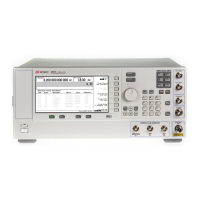E8257D/67D, E8663D PSG Signal Generators Service Guide
Troubleshooting
Troubleshooting the RF Path
1-75
Troubleshooting the RF Path
Troubleshooting RF Path procedure:
• preset the signal generator
• set a frequency
• open ALC loop (ALC Off)
• set signal generator to maximum power
• check power levels in the RF path using “Troubleshooting RF Power Levels”, below.
Troubleshooting RF Power Levels
The following information has been provided to aid in troubleshooting power levels in the RF path:
• RF Block Diagrams (see Figure 1- 9 on page 107 and Figure 1- 10 on page 109 for the E8257D, and Figure 1- 13 on
page 115 and Figure 1- 14 on page 117 for the E8267D). The block diagrams show signal flow, path frequency
ranges, and minimum power levels ts a few key points in the RF path.
•A Gain/Loss table (Table 1- 30 on page 1- 105). The table provides the minimum gain or maximum loss level
between the input and output for each part
When troubleshooting the instrument, the troubleshooting procedure may refer you to the RF Block Diagram, the
Gain/Loss table, or both.
Examples:
Verifying the gain or loss of a part – Locate the part in the Gain/Loss table. Measure the output and input power
levels. Subtract the input from the output to determine the gain or loss. If the part is not meeting the gains or losses
specified (the gain is less than specified or the loss is more than specified), the part most likely needs to be replaced.
In cases where the part fails to meet its specification but comes very close, calculate and measure the minimum input
power level into the part before replacing the part.
Verifying the minimum power into a part – Locate a point on the RF path where output power is specified, then use
the Gain/Loss table to calculate the minimum power level at the specific location. If the minimum power level is not
present, measure the output of the first device showing a power level on the RF Block Diagram, then measure the
input and output power level for each device in the path until the defective part is located.
Internal FM Distortion Perform FM adjustments.
If still failing check A11 Pulse/Analog Modulation Generator and A6 Frac–N.
Internal Phase Modulation Distortion Perform FM adjustments.
If still failing check A11 Pulse/Analog Modulation Generator and A6 Frac–N.
External FM Deviation Accuracy Perform FM adjustments.
If still failing check A11 Pulse/Analog Modulation Generator and A6 Frac–N.
External Phase Modulation Deviation Accuracy Perform FM adjustments.
If still failing check A11 Pulse/Analog Modulation Generator and A6 Frac–N.
External Pulse Modulation ON/OFF Ratio If the frequency is ≤3.2 GHz, check the
A11 Pulse/Analog Modulation Generator or the A8 Output.
If the frequency is >3.2 GHz, check the
A11 Pulse/Analog Modulation Generator and the A10 ALC.
Harmonic Spurious
Sub–Harmonic Spurious
Refer to “Troubleshooting Harmonic Spurious” on page 1- 78.
Non–Harmonic Spurious Refer to “Troubleshooting Non–Harmonic Spurious” on page 1- 81.
Single–Sideband Phase Noise Refer to “Troubleshooting the RF Path” on page 1- 75.
Internal EVM Digital Modulation Quality Perform I/Q and digital calibrations.
Digital Modulation Power Relative to CW Perform I/Q and digital calibrations.
Performance test that is failing... Action to perform...

